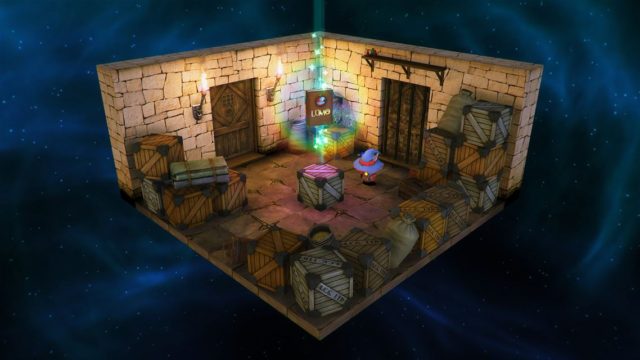Who here remembers Knight Lore on the ZX Spectrum? Anyone? There are a few at the back I can see…the old ones with walking sticks and grey hairs – they remember it. Well, Lumo is not a remake of this game or even a re-imagining of this game, but it has homages to it and many more games like it from the 80’s and early 90’s. The title screen brings back memories of when you would load a game each time on your cassette recorder and it could take up to an hour to load, then crash in the last minute and you’d have to start again. Happy days. The developer Gareth Noyce is someone who adored that period, but at the same time, wants to make a completely new experience that brings in new audiences, as well as still catering for the old. But does it work?

Lumo starts with a young boy rushing into a library to play his favourite video game, before getting sucked into the game itself. You find yourself as a small magician, with no powers, stuck in an isometric dungeon world with no tutorial to help you out. Your mission is to explore the magical strange world with its 400 plus rooms, solve puzzles, collect objects and generally immerse yourself in a new, but familiar experience. You gain new powers, like jumping, as you progress and a wand later on that creates light, revealing secrets and scaring monsters away. Areas previously unworkable become open with new powers gained and help you progress through the world. There are loads of items to collect like beautiful hand drawn maps, similar to those you used to see when people used to play D&D, mix tapes and artefacts like a retro floppy disc drive.
The camera is, in homage to its source material, a fixed one. You can’t move it for a better view for a jump, or a different perspective on a certain level; it’s stuck always at a certain angle. This is a challenge and it takes a while to get used to. Jumps and vertical perspective in Lumo can be a major problem and will cause a lot of frustration. At the start there are three options on how you want to set your controls up to move across the map – all I can say is choose wisely and try all three, because it really makes a difference to your enjoyment of the game.
Regarding death, well lets just say I’ve recently received an achievement for dying over two hundred times quite quickly…you get the idea…you die a lot. You can choose to play the easy way like me, where you have unlimited lives, and after each death you appear at the start of the room. Or you can play the hardcore and old-fashioned way where you have a certain number of lives to COMPLETE THE WHOLE GAME. Sorry I can’t believe that’s how we played games back then…I for one cannot go back to those dark days. But each to their own.

The levels themselves are a really good mix of puzzles, some action sequences and skill-based rooms. It’s almost like it’s taking some influences from TV hit Crystal Maze without the eccentric presenter. There is some really inventive gameplay here and it really does surprise me at every turn. When you think you might know what the game is about, it tips you on your head, ruffles your hair and spins you right round.
Story wise it’s all about games, and how we play games then and now I think. There are no words or text to help you understand your journey but there are clues everywhere to ensure you develop your own theories. It has a British humour to it and the only piece of spoken word is in the menu when a kids voice, that scares the hell out of the dog, whispers “Hello?”. Occasionally throughout the game you find yourself in a kids bedroom or a hallway, or behind the scenes with the people making the game. The quirky element really adds to the mystery and enjoyment of the game.
The presentation of Lumo is retro but has a completely modern feel to it. The main character is beautifully drawn and designed and the world is charming, surprising on every level. The colour palette is very well used and when it goes to the stranger worlds, the developer really pushes the boat out. Sound wise the game has a great score that made me feel nostalgic without just copying anything from the good old days. There are a couple of places that it really surprises you as well, all I’m saying is ‘robot in the cloud’. All the sounds effects are good and work well within the gaming world and how you’re reacting to it.

Overall I would recommend anyone to have a go at Lumo. The game developer obviously knows how to make a good game and really knows his 80’s and 90’s video game. There’s a lot of game here as well for an indie title and you’ll be spending a good deal of time getting through it – and plenty more of your hard earned time collecting all the secrets. For some the old school mechanics might drive you mad and the constant dying might make you not want to go any further. Jumping can be a torture too, but when you master it and get to the other side of the room, for me it’s worth the hundred or so attempts it sometimes took.
